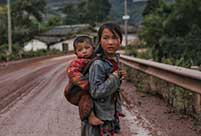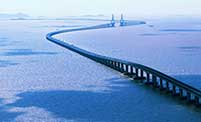

BEIJING, Dec. 24 -- China's economy has entered a "new normal" and those fretting over disappointing data in traditional sectors, will have to adapt.
The structure of China's economy has changed and traditional measurements, including GDP growth and industrial output, are insufficient to evaluate and predict economic performance.
True, according to traditional measures, China's economy is losing steam: GDP growth slowed to its weakest pace since the global financial crisis and is widely expected to post its lowest annual rate in a quarter of a century this year; industrial output increase also slowed, to 6.2 percent last month, from the double-digit rates regularly recorded before. Other indicators, including power consumption, cargo freight volume and new bank loans, also point to weakness.
These indicators, however, increasingly tell only half the story as China is now running a two-speed economy.
A major characteristic of this two-speed economy is the emergence of the the services sector, which now accounts for half of China's GDP.
While the industry loses momentum, services are prospering. Tourism revenue, theater box office returns and financial services revenue all registered strong gains.
Retail sales growth is consistently above 10 percent each year, supported by a sound labor market and stable wages. Hi-tech industries also reported stronger-than-average output growth.
Despite moderation in growth, the economy is moving in the desired direction, or the "new normal." Yet the moderation is what policy makers have been expecting -- a by-product of structural reform and the short-term pain to be paid for long-term gain.
Given the size of the economy, overdependency on investment and trade is no longer tenable. Instead of temporary fixes such as quantitative easing and competitive currency devaluation, the country chooses structural reform.
The economic restructuring has challenges, during which some traditional industries will suffer and decline -- steel, for example -- while others will be boosted on the back of domestic demand, innovation and government support.
The divergence is unavoidable and will be an evidence that the reform is working as intended.
Inevitably, though, rebalancing the economy will be a slow and bumpy process and, in short term, there will be times when some investors and analysts focus too much on traditional indicators. But, to observe the dynamically changing economy, a more integrated measure for both quantity and quality are needed.
 Are these the world’s scariest landing strips?
Are these the world’s scariest landing strips? In pics: Left behind children in China
In pics: Left behind children in China Eight modern day engineering marvels of China
Eight modern day engineering marvels of China Chinese beauty with sexiest bottom
Chinese beauty with sexiest bottom Charming female bodybuilders of Chengdu University
Charming female bodybuilders of Chengdu University Polish sports stars strip off for risqué calendar
Polish sports stars strip off for risqué calendar Spectacular aerial photos of the Three Gorges
Spectacular aerial photos of the Three Gorges Contestants of Mrs. Globe pose for photo in Shenzhen
Contestants of Mrs. Globe pose for photo in Shenzhen
 Bikini models attend hot pot banquet in Hefei
Bikini models attend hot pot banquet in Hefei Top 20 hottest women in the world in 2014
Top 20 hottest women in the world in 2014 Top 10 hardest languages to learn
Top 10 hardest languages to learn 10 Chinese female stars with most beautiful faces
10 Chinese female stars with most beautiful faces China’s Top 10 Unique Bridges, Highways and Roads
China’s Top 10 Unique Bridges, Highways and Roads Surviving a cross-cultural Christmas
Surviving a cross-cultural Christmas Tough tasks ahead for economic reformers
Tough tasks ahead for economic reformers Chinese NGO’s anti-poaching efforts met with resistance in Zimbabwe
Chinese NGO’s anti-poaching efforts met with resistance in Zimbabwe Private security companies struggle to go abroad due to legal restrictions
Private security companies struggle to go abroad due to legal restrictionsDay|Week